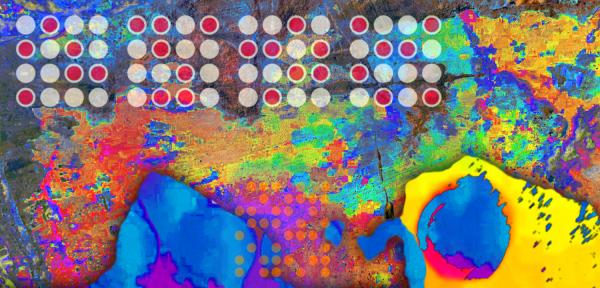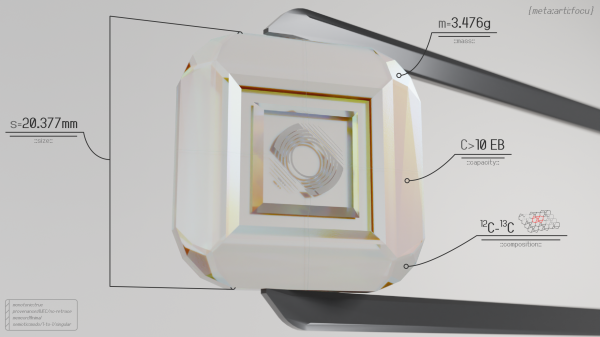BY LETTER
Information Storage
Technology > Application > Computronics
Science > Physics > Information Physics
Science > Information Theory
Science > Physics > Information Physics
Science > Information Theory
 Image from Johnny Yesterday |
There are two categories of information that can be stored long-term: digital and analogue. Digital information storage requires, at minimum, two types of contrasting entities to store the states that encode digital data. Analogue storage requires a bounded continuum of matter to be structured at different scales to store information. Because matter is quantized in atoms and particles, digital information can be stored at far higher densities than analogue information. Within a given storage media technology paradigm, the latency is strongly coupled with the amount of data stored in a given spatial volume. This is because read/write hardware does not store information. Consequently, the quicker that data can be retrieved or written (e.g. by parallel hardware) the less space can be devoted to housing the storage media, lowering the overall information storage density per unit volume.
 Image from Tasp |
High-Density Storage - Data Crystal
The densest storage media can achieve an information density on the order of one bit per atom. An example is data diamond, which represents zero and one bits using carbon-12 and carbon-13 isotopes to store the binary states.Data diamond is the most information-dense variety of the bi-isotopic data crystal (BDC) storage media. However, diamond has disadvantages as an archival storage medium for high value data. It burns in an oxygen atmosphere, and more importantly, it is damaged by ionizing radiation. Proper storage conditions can protect diamond from fire, but cosmic rays are difficult to shield against. Because of their refractory properties and resistance to ionizing radiation, boron subphosphide and boron carbide are the preferred BDC media for critical archival applications. Each boron icosahedron, which is made of twelve boron atoms of a single isotope, stores one bit.
Cubic boron nitride, silicon carbide, and corundum also find some use as bi-isotopic data crystals. They have greater stability than diamond.
The read speed of BDCs is relatively slow because they require precision molecular disassembly and atomic mass weighing of each atom. This drawback largely relegates BDCs to data archival applications.
High-Density Storage - Molecular Tape
Selectively fluorinated polyethylene molecular data tape has a storage density of 1 bit / 3 atoms. Selectively fluorinated polysiloxane molecular tape has greater thermal, chemical, and UV resistance than polyethylene, but has a slightly lower storage density of 1 bit / 10 atoms. Their read/write speeds are much quicker than BDCs, making them appropriate for middle-latency high density storage applications.DNA is the most common storage medium in Terragen biotechnology and organic life forms derived from Terran templates. Although it is a relatively fragile medium, under proper conditions DNA can remain intact enough for dormant microorganisms to revive after many millions of years of suspended animation. Organisms or biotech may contain multiple copies of their genomes in each cell and employ error correcting mechanisms that compare codes to identify mutations and repair them. This gives them a substantial level of resistance against radiation-induced mutations causing lethal effects in the short term, and greatly reduces the rate of evolution of populations over time.
Magmatter analogues of molecular data tape are created and utilized by S3 and higher transapients. Their bits-to-mass ratios are comparable to conventional matter molecular tape, but like all magmatter they have extreme mass-to-volume ratios, allowing for ultra-compact storage. Because of magmatter's extremely high binding energy, magmatter data tape can survive all but the most energetic conditions, and it has an extremely high read/write speed.
Active Storage
Baryonic high-density media, even those that are resistant to ionizing radiation breaking chemical bonds, are still vulnerable to data corruption due to cosmic ray spallation or neutron radiation. These forms of radiation cause nuclear transmutation (the conversion of an isotope into another isotope, or the conversion of one element into another). To resist such corruption, numerous copies of each data set are stored, and they are periodically compared against one another and repaired in an error-correction process. Active storage can preserve high-density data integrity into cosmological deep time.Medium-Density Storage
Capillary-memory is a category of volumetric storage media that is based on storing data inside matrices of numerous nanoscale tubes. Data is read from, or written into, capillary-memory by quasi-2D matrices of nanomachinery. Bits are stored within the capillaries by stacked nanoscale cylinders that have contrasting heights. Cylinders are composed of inert materials like boron carbide or boron nitride. This architecture allows near-high density data storage with relatively low latency and archival stability.Capillary-memory is designed to allow straightforward replacement of the nanomachinery when it is broken by radiation damage.
Capillary-memory comes in read/writable and read-only versions. In read-only memory, the cylinders are linked together in a stack by wire or chain, or they are joined into a continuous corrugated rod, preventing the erasure or reordering of bits.
Boron carbide and boron subphosphide ceramics are combined with tungsten carbide nanoparticles to form x data crystals. X-crystals utilize different shapes and/or sizes of the tungsten carbide nanoparticles to store bits. Data is written into x-crystals by molecular manufacturing, but is read out by x-ray nanographic scanning. Their read speed has relatively low latency, and they are a preferred medium for durable read-only storage.
X data-tape is similar to x-crystals, but instead of data being stored in rigid crystal wafers, data-tape is flexible, consisting of boron nitride or boron carbide nanomaille tape dotted with tungsten carbide nanoparticles. Because it is highly linear, being stored on reels, spools, or in cassettes, it has relatively high data retrieval latency. Its advantage over x-crystals is that it stores more data per unit volume.
Low-Density Storage
Corundum, silicon carbide, fused quartz, and other hard, stable, inorganic, clear materials are used to form optical refractive data crystals. ORDCs store bits using microscopic dots with a different refractive index than the bulk material. Bits are written into ORDCs by molecular manufacturing or femto-second laser pulses. Ultraviolet-scanned ORDCs have the smallest dots, and therefor highest bit density.Analogue Storage
Although the vast majority of information is stored digitally, digital storage has one weakness as an archive: it is not plainly readable. By its nature, digital information is stored as code. If for some reason the codec for reading a particular set of digital data became lost, it cannot be read. Without codecs, the bits that store the text of a book are not differentiable from those that store a photograph, a song, an autofac manufacturing template, or any other category of information. The preservation of codecs is generally given very high priority, however because of the number of codecs that have been used over the millennia, there have been cases of codec loss due to various causes.The densest form of analogue information storage is microform. Although microform exists that can only be read by x-ray or near-field microscopes, the majority of microform is read by standard far-field optical microscopes. Optical microform is typically diffraction-limited to 1000X magnification. At 1000X, 2.5 x 10^11 words of text 2 can be stored in a volume of 1,000 cm^3. Images (photographs, holograms, technical drawings, artworks, motion pictures) can likewise be reduced. Sound recordings can be stored by visual representation of the waveform. Microform is mostly created by molecular manufacturing, but a form of black-and-white can be created using photographic technology that was known in the First Century BT 3.
The most reliable information from Pre-Technocalypse times survived the malware plagues and corruption on microform and other read-only media. Because of this, microform knowledge caches are generally carried aboard outward-bound interstellar spacecraft. Knowledge caches are buried in geological-time-stable locations as backups.
Lower density macroscopic analogue storage media include: codices, printed photographs, paintings, posters, and decals, engraved, etched, or carved metal, glass, ceramic, stone, bone, and other materials; mosaics; stained glass; patterned fabric; petroglyphs; slat books; scrolls; and patterned skin (e.g. tattoos and scarification.)
Footnotes
[1] - Theoretical maximum storage capacity of high-density media:Data diamond: 1.75 x 10^23 bits/cm^3
Boron carbide data crystal: 1.83 x 10^21 bits/cm^3
Molecular tape: 2.6 x 10^22 bits/cm^3
Linear DNA: 10^21 bits/cm^3
Because the read/write mechanisms and other hardware are not factored in, the density achieved in practical applications is always lower to some degree.↩
[2] - The figure of 2.5 x 10^11 words per 1,000 cm^3 is based on several assumed parameters: all words are printed using letters that are 2-by-2 micrometers in size, all words have a length of ten letters, there are no spaces between words or lines of text, and the microform is printed on 0.1 mm-thick sheets, which allows 10 m^2 of sheets to be stored in 1,000 cm^3. At 2-by-2 micrometers, relatively complex shapes (such as some logographic characters) are resolvable; details can be loosely resolved down to a width/height above approx. 0.2 micrometers--the diffraction limit of visible light. Smaller letters with a simple form designed for microscopic resolvability can improve the word count density over the above figure. 2.5 x 10^11 words is equivalent to 125,000 thousand-page books with 2,000 words per page. ↩
[3] - Standard microform sheets are composed of stable pigments or optical nanostructures/microstructures printed inside a clear, hard, semi-rigid, inert material--typically a corundumoid platelet-nanomaille variant. Microform tape is similar, but is flexible and wound on storage spools. ↩
Related Articles
- Data Media
- Data Slug
- Information - Text by M. Alan Kazlev
A sequence of data that is meaningful in a process, such as the DNA code of an organism or the bits in a computer program. Information is the opposite of noise. - Memory Box - Text by Todd Drashner
Data storage unit used to contain the mind-state. Also contains a digitized copy of the owners biocode to allow the nano- construction of a new body if the original is destroyed. A standard memory box is a rectangular solid approximately of dimension 3x1.5x.75cm. Memory boxes are typically copied at least three times and the copies kept in separate locations. They are also built to be as close to indestructible as their owners can afford. A standard design typically involves multilayer buckytube shells interspersed with foamed ceramic thermal insulation. - Memory Retrieval - Text by Anders Sandberg
If one has a constant learning rate and a brain (or equivalent) of any given size then eventually the oldest memories are forgotten unless an effort is made to refresh them. If one decreases the learning rate then senility is a danger. As an alternative one can add extra memory - which in the long run means becoming posthuman (or postbiont, postvec, etc.) to manage all that information. Another alternative is to undergo periodic "childhoods" where the brain is made more plastic and one forgets a bit but not everything from previous incarnations, but this entails some loss of identity and some personality shift. Corporations like Psyber Retrievals, Inc - "Let us remember it for you!" - offer memory storage units for this reason. - Memory Storage, Long-Term - Text by Steve Bowers
Memory storage for posthumans thousands of years old is often a problem. One popular (but clumsy) solution among some clades is to employ computronium implants, or even a small drone floating about for all the very-long-term memory storage. More elegant solutions involve a nanosome in each posthuman cell writing memory directly to redundant or specially set aside nuclear DNA.
Appears in Topics
Development Notes
Text by Johnny Yesterday
Initially published on 30 July 2021.
Data Diamond image by Tasp added september 2024
Initially published on 30 July 2021.
Data Diamond image by Tasp added september 2024






